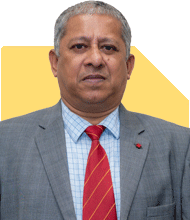Young mom of two seeks advice on doubling savings in 5 years
Ramalingam Kalirajan |8191 Answers |Ask -Follow
Mutual Funds, Financial Planning Expert - Answered on Jul 15, 2024
He has an MBA in finance from the University of Madras and is a certified financial planner.
He is the director and chief financial planner at Holistic Investment, a Chennai-based firm that offers financial planning and wealth management advice.... more

Im 33 year old women with 2 kids, one is around 3 year old , my daughter and my son is 3 months old. I have savings around 9 lakhs and i want to double the same in next 5 years to get total of savings 20 lakhs .pls suggest me how should i go about it . My net salary is around 60k and expenses around 20 k
Evaluating Your Current Financial Position
Your net salary is Rs 60,000 per month, with expenses around Rs 20,000. This leaves you with a surplus of Rs 40,000 each month. You have Rs 9 lakhs in savings. We need to deploy these savings wisely and also utilize your monthly surplus effectively.
Investment Options to Double Your Savings
Mutual Funds
Investing in mutual funds can offer good returns over five years.
Benefits of Actively Managed Funds:
Professional Management: Fund managers adjust portfolios based on market conditions.
Diversification: These funds spread investments across various sectors, reducing risk.
Systematic Investment Plan (SIP)
A SIP allows you to invest a fixed amount monthly in mutual funds. This helps in averaging costs and reducing market volatility impact.
Advantages of SIP:
Rupee Cost Averaging: Buys more units when prices are low and fewer when prices are high.
Discipline: Encourages regular saving and investing habits.
Creating an Investment Strategy
Lump Sum Investment:
Invest your Rs 9 lakhs savings in a diversified portfolio of mutual funds.
Monthly SIPs:
Allocate a portion of your Rs 40,000 monthly surplus into SIPs. For example, investing Rs 30,000 monthly in mutual funds can yield significant returns over five years.
Building a Diversified Portfolio
A well-diversified portfolio can help in achieving your financial goals.
Equity Mutual Funds
These funds invest in stocks and have the potential to deliver high returns.
Benefits:
High Growth Potential: Equities generally offer higher returns compared to other asset classes.
Inflation Hedge: Equity investments can outpace inflation.
Debt Mutual Funds
These funds invest in fixed-income securities like bonds.
Benefits:
Stability: Lower risk compared to equity funds.
Regular Income: Suitable for conservative investors looking for steady returns.
Balancing Risk and Return
Investing in equity mutual funds offers higher returns but comes with higher risk. Debt mutual funds are more stable but offer lower returns. A balanced approach is to invest in both, creating a mix that aligns with your risk tolerance and financial goals.
Avoiding Common Pitfalls
Avoiding Index Funds
Index funds mirror market indices. They may not outperform the market.
Disadvantages:
Lack of Flexibility: No active management to capitalize on market opportunities.
Market Risk: Entirely dependent on market performance.
Actively Managed Funds:
Offer the expertise of fund managers who adjust portfolios for better returns.
Importance of Regular Funds
Avoiding Direct Funds
Direct funds require investors to manage their investments.
Disadvantages:
Complexity: Requires deep market knowledge.
Time-Consuming: Continuous monitoring and adjustments needed.
Benefits of Regular Funds:
Managed by professionals, offering better potential for growth.
Emergency Fund
It's crucial to maintain an emergency fund. This ensures financial stability during unforeseen circumstances.
Recommendation:
Keep aside Rs 1-2 lakhs as an emergency fund, invested in liquid or ultra-short-term funds for easy access.
Insurance Coverage
Ensure you have adequate life and health insurance.
Life Insurance:
Adequate cover ensures financial security for your family.
Health Insurance:
Protects against medical emergencies and high healthcare costs.
Financial Discipline
Sticking to your investment plan requires discipline.
Regular Review:
Monitor your investments periodically to ensure they are on track.
Avoid Emotional Decisions:
Stay invested during market fluctuations to reap long-term benefits.
Importance of Certified Financial Planner (CFP)
A CFP can provide personalized advice tailored to your financial situation.
Benefits:
Expert Guidance: Professional advice on investment strategies.
Comprehensive Planning: Covers all aspects of financial planning, ensuring holistic growth.
Long-Term Financial Planning
While doubling your savings in five years is a short-term goal, consider long-term planning as well.
Retirement Planning:
Ensure you are saving adequately for a comfortable retirement.
Child’s Education:
Plan for your children's education expenses early.
Final Insights
Doubling your savings in five years is achievable with a strategic and disciplined approach. Invest your Rs 9 lakhs in a mix of equity and debt mutual funds. Utilize your Rs 40,000 monthly surplus through SIPs. Maintain an emergency fund and ensure adequate insurance coverage.
Regularly review your investments and avoid emotional decisions. Seek guidance from a Certified Financial Planner to ensure your financial plans are on track.
With a balanced approach and disciplined investing, you can achieve your financial goals and secure a bright future for your family.
Best Regards,
K. Ramalingam, MBA, CFP,
Chief Financial Planner,
www.holisticinvestment.in
You may like to see similar questions and answers below
Ramalingam Kalirajan |8191 Answers |Ask -Follow
Mutual Funds, Financial Planning Expert - Answered on Apr 15, 2024
Ramalingam Kalirajan |8191 Answers |Ask -Follow
Mutual Funds, Financial Planning Expert - Answered on Jul 19, 2024
Ramalingam Kalirajan |8191 Answers |Ask -Follow
Mutual Funds, Financial Planning Expert - Answered on Jun 25, 2024
Ramalingam Kalirajan |8191 Answers |Ask -Follow
Mutual Funds, Financial Planning Expert - Answered on Apr 05, 2025
Radheshyam Zanwar |1516 Answers |Ask -Follow
MHT-CET, IIT-JEE, NEET-UG Expert - Answered on Apr 05, 2025
Dr Upneet Kaur |28 Answers |Ask -Follow
Marriage counsellor - Answered on Apr 04, 2025
Milind Vadjikar |1153 Answers |Ask -Follow
Insurance, Stocks, MF, PF Expert - Answered on Apr 04, 2025
Prof Suvasish Mukhopadhyay |544 Answers |Ask -Follow
Career Counsellor - Answered on Apr 04, 2025
Nayagam P P |4411 Answers |Ask -Follow
Career Counsellor - Answered on Apr 04, 2025
Ramalingam Kalirajan |8191 Answers |Ask -Follow
Mutual Funds, Financial Planning Expert - Answered on Apr 04, 2025
Radheshyam Zanwar |1516 Answers |Ask -Follow
MHT-CET, IIT-JEE, NEET-UG Expert - Answered on Apr 04, 2025
Prof Suvasish Mukhopadhyay |544 Answers |Ask -Follow
Career Counsellor - Answered on Apr 04, 2025
Milind Vadjikar |1153 Answers |Ask -Follow
Insurance, Stocks, MF, PF Expert - Answered on Apr 04, 2025

























